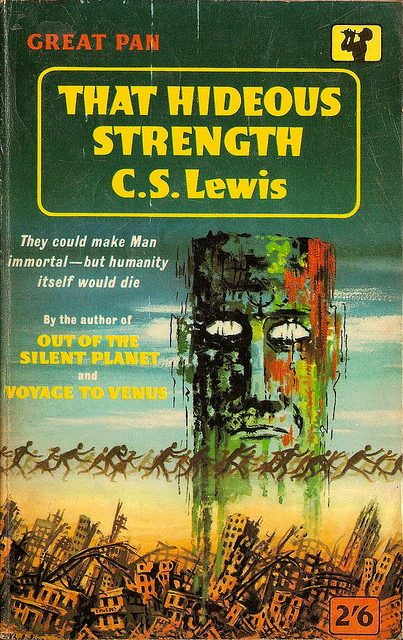 This is Cascading Stylesheet Lewis’s most 1984-like story, with an important difference. 1984 takes place in the middle of the party. That Hideous Strength is about when the party’s just beginning. Lewis, while writing a story about spiritual warfare and cosmic redeption, also outlines how a totalitarian government could believably take power.
This is Cascading Stylesheet Lewis’s most 1984-like story, with an important difference. 1984 takes place in the middle of the party. That Hideous Strength is about when the party’s just beginning. Lewis, while writing a story about spiritual warfare and cosmic redeption, also outlines how a totalitarian government could believably take power.
Technically the third part of the Space Trilogy, it’s probably better read as a standalone book. Nobody goes into space this time. The tone is pessimistic and dystopian. A few characters nominally reappear (a nice shock occurs when you learn Lord Feverstone’s real name), but they seem very different to how we knew them.
The principle character is Mark Studdock, a social climber who gets taken on by an organisation called NICE, which aims to reform and improve society via science unencumbered by ethics. Soon it’s clear that the party is in the thrall of the demonic “eldil” – this is another area where That Hideous Strength is better read on its own. Otherwise you’ll spend many pages patiently waiting for Mark to realise things that have been obvious to you from the beginning.
There’s some vivid and disturbing writing (thanks to NICE, having your head guillotined is no obstacle to your contiunued survival), and a some interesting characters. Lewis stretches himself a little here – there’s a cleric who’s a villain, and an S&M-obsessed female police chief. No swear words, though – Lewis abhorred profanity, and it makes the book’s gritty setting seem false. We also get a romantic relationship rendered in pure tin. Lewis was many things…but he was not a romance writer.
But That Hideous Strength is not a cold book. Here as elsewhere, Lewis finds room amidst religious and sociopolitical issues for humanistic themes that are genuinely moving.
“He looked back on his life, not with shame but with a kind of disgust at its dreariness. He saw himself as a little boy in short trousers, hidden in the shrubbery beside the paling to overhear Myrtle’s conversation with Pamela, and trying to ignore the fact that it was not at all interesting when overheard. He saw himself making believe that he enjoyed those Sunday afternoons with the athletic heroes of Grip, while all the time (as he now saw) he was almost homesick for one of the old walks with Pearson—Pearson whom he had taken such pains to leave behind. He saw himself in his teens laboriously reading rubbishy grown-up novels and drinking beer when he really enjoyed John Buchan and stone ginger. The hours that he had spent learning the slang of each new circle, the assumption of interest in things he found dull and of knowledge he did not possess, the sacrifice of nearly every person and thing he actually enjoyed, the miserable attempt to pretend that one could enjoy Grip, or the Progressive Element, or the N.I.C.E.—all this came over him with a kind of heartbreak. When had he ever done what he wanted? Mixed with the people whom he liked? Or even eaten and drunk what took his fancy? The concentrated insipidity of it all filled him with self-pity.”
The final clash between good and evil has a predictable ending, and Lewis insists on weaving the tale of King Arthur and Merlin into the story for some unknowable reason. Still the unusual setting and interesting characters makes for grim, exciting, and memorable reading.
There’s a newly released edition of this book with annoying cover art – a giant bear, or something. Looks like a bad movie. Past editions have better artwork. Deceptive though it is, you can’t argue that the book is a bit deceptive, too. It barely has anything to do with the rest of the Space Trilogy. Technically it’s the third in a series. Spiritually, it’s distinct from anything else to come from the pen of Lewis. This is a very different book.
No Comments »
Comments are moderated and may take up to 24 hours to appear.
No comments yet.
